The Opportunity Index
Perceptions of mobility & the job search
Since the beginning of 2015 in the U.S. alone, there have been over 5 million open jobs at any given time, according to the Bureau of Labor and Statistics. And yet, companies are having a hard time finding the right talent to fill these open roles — especially when it comes to in-demand functions like engineering, sales, and skilled manufacturing.
According to ManPower Group’s 2016-2017 Talent Shortage Survey, 40% of hiring managers report having difficulty filling jobs, up 2% from 2015, and the highest recorded since 2007. The problem seemingly isn’t a lack of candidates; it’s a clear lack of relevant candidates. According to Lever’s Recruiting Benchmarks 2016, only 1 in 100 candidates for any given role is ever hired, with 45% of all candidates marked as ‘underqualified’ by hiring stakeholders.
This global talent shortage isn’t just a problem when it comes to hiring; nearly 7 out of 10 executives surveyed by Deloitte University Press say they have a high level of concern about simply retaining critical talent. In fact, 80% of hiring managers surveyed by ManPower Group believe most top management challenges stem from a shortage of skilled talent — including finding highly-skilled people (28%), rising costs (27%), and holding onto experienced staff (25%).
To uncover why the job search — and hiring process — is so broken, Hired commissioned an online survey conducted by Harris Poll to survey 2,557 full-time employed adults aged 18 or older in the US, the UK, and Australia.
Our hope is that these findings provide actionable insight for job seekers, companies, and hiring managers worldwide. By better understanding how individuals perceive professional mobility, opportunity, and job satisfaction, we can improve the job search and better match the right talent with the right openings at the right time.
Looking for jobs stresses 8 in 10 employed adults out.
Eight in 10 working adults (83%) globally say looking for a job is at least somewhat stressful, with 39% feeling it’s very stressful. Women are more likely than men to say looking for a job is stressful (86% vs 81%) and Boomers and older (aged 52 or older) (88%) are more likely than any other generations (Millennials aged 18-36) (79%) and (Gen Xers aged 37-51) (83%) to say looking for a job is stressful.
Job search stress levels
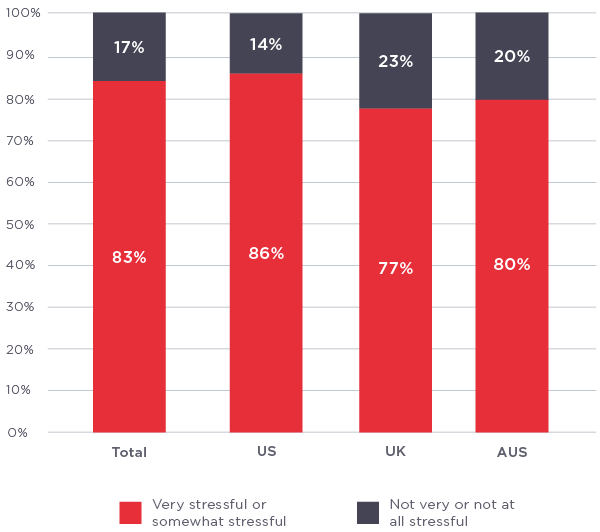
Looking for a job is more stressful than getting a root canal.
The perceived stress of looking for a job (83%) is more prevalent than the perceived stress for that of most all other notoriously stressful activities — including moving (82%), planning a wedding (78%), getting a root canal (73%), public speaking (70%), being trapped in an elevator (69%), doing taxes (50%), or spending a weekend with their in-laws (35%).
Stressful Activities
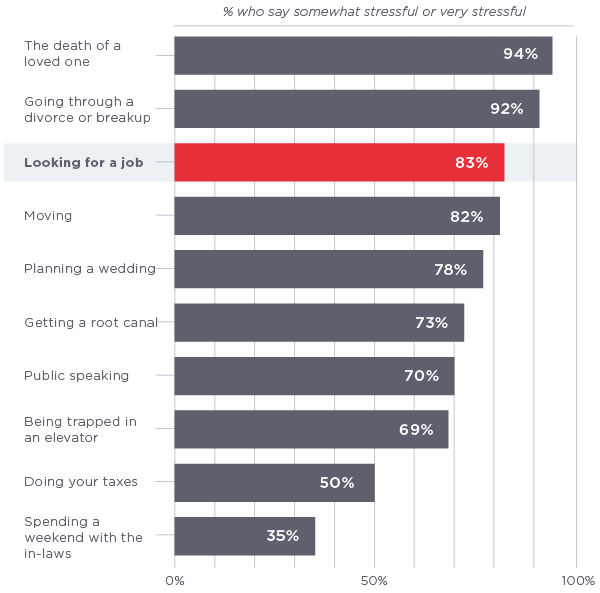
Interviewing is one of the most stressful parts of the job search.
What about the job search stresses people out so much? Working adults say the interview process and starting over in a new role are two of the most stressful parts of finding a new job (tied at 47% each).
Most stressful parts of job search
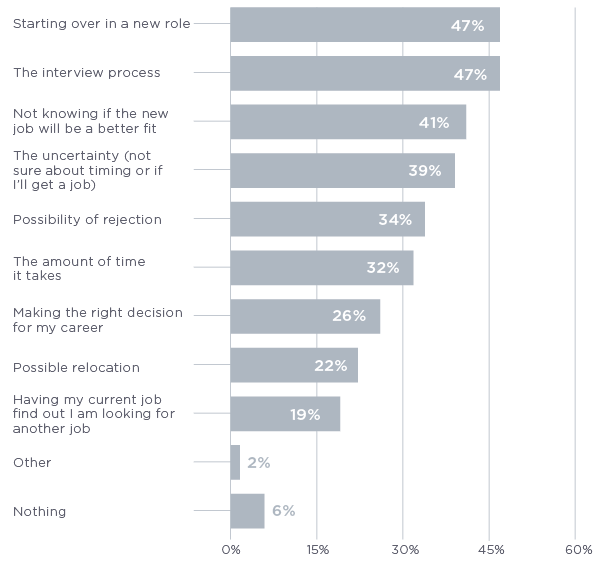
Job seekers want personalized support
Many working adults find themselves not only stressed about the job search process, but also feeling unequipped to navigate the job search. This is illuminated by the top requests for making the job search easier, which primarily revolve around receiving more relevant and personalized information. The vast majority of working adults (85%) feel like something could make the job search process easier for them, including: getting matched with companies who would be a good fit for their skills and interests (45%); help finding jobs that better match their interests and/or skillset (36%); and knowing more about exciting companies with relevant opportunities (29%).
What would make job search easier
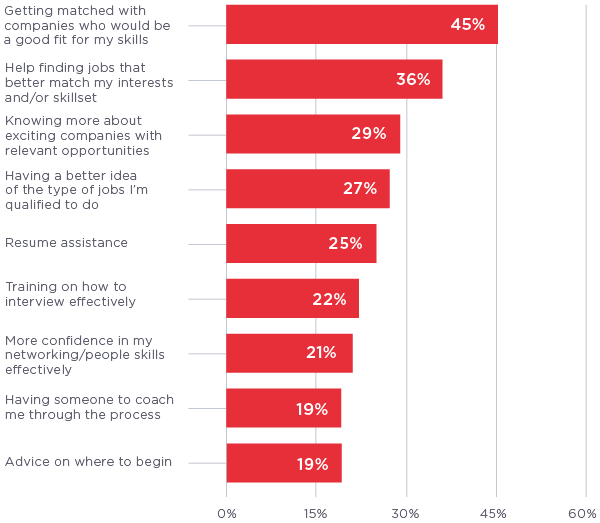
Most job search activities don’t lead to actually getting hired
Despite reporting taking a number of actions during the job search process, the top two ways working adults generally get jobs are by applying to the company directly (30%), or by a referral from someone who worked at their company (21%).
Top job search activities
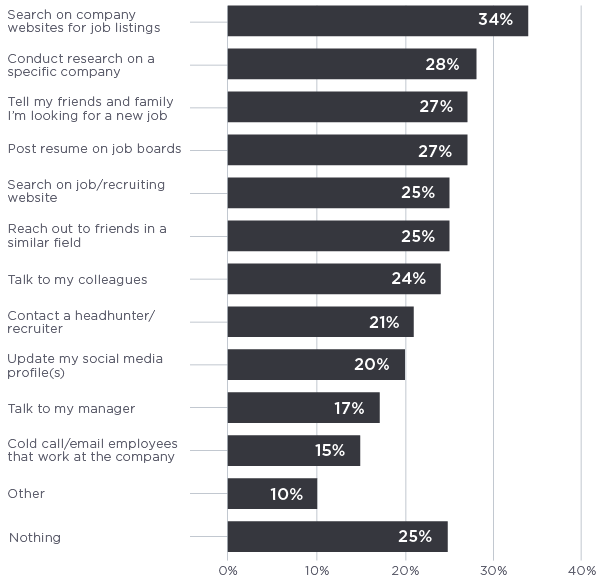
How people get jobs

Networks help people find and get good jobs
Professional and personal connections are increasingly an important tool for finding and getting jobs. Referrals (either from someone in the individual’s network (11%) or from an employee at the company (21%)) are two of the ways many working adults found their current job, according to survey responses. Of note: This number for referrals is even higher (30%) for people who love their jobs. In fact, 55% of working adults would rather find a job through someone they know than apply to one themselves, and a similar percentage (55%) say they are more likely to apply for a job if a friend works at the company.
Passive job seekers outnumber active job seekers by almost 3x
Only 14% of working adults are actively looking for a new job, while 40% say they aren’t actively looking, but are open to hearing about new job opportunities if contacted. The majority of employed adults (63%) don’t feel like they need to spend time actively searching for a new job.
Job search stages

2 in 5 working adults daydream monthly about leaving their current job
While only 14% of working adults are actively looking for a new job, 1 in 5 (21%) daydream about leaving their current job on a weekly basis, and more than 2 in 5 (44%) admit they daydream monthly (or more frequently). Similarly, 45% of working adults imagine the kind of job they would want next at least once a month. And, many appear to be taking even more — passive or active — steps (especially in the UK and Australia). At least once per month, more than 4 in 10 (42%) spend time browsing websites or job boards for potential openings in their field. And at least monthly, many working adults take even more initiative by networking with their social circle (27%); updating their resume and/or LinkedIn account (20%); and checking the opportunities with companies they admire (32%).
Passive job seeking activities
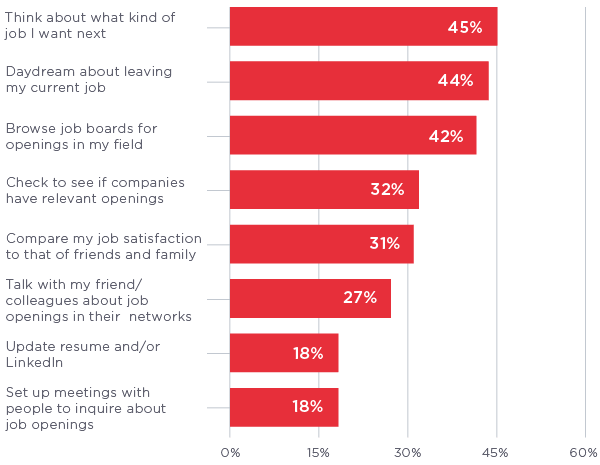
2 in 3 employed adults would take a pay cut to be happy at work
While 42% of working adults say they love their jobs, most employed adults (66%) would still take a pay cut to be happier at work — to the tune of 8% (on average) of their current salary. In fact, two out of three working adults (66%) say they would take a pay cut of at least 1% to be happier at work, with more than 1 in 10 (11%) saying they would take a cut of 20% or more to be happy at work. Of all generations surveyed, millennials are the most likely to say they would a pay cut for happiness at work (millennials, 78%; gen Xers, 63%; boomer or older, 55%).
Better opportunity elsewhere is the #1 reason people leave their jobs
When asked why they left their last job, respondents who have worked at more than one company over the course of their career said “because the opportunity was too good to pass up,” followed by “I was being underpaid” (both 26%), followed by “limited opportunity for advancement” (21%).What’s interesting about these findings is that two of the top three reasons for leaving a job have to do with the perceived lack of opportunity; first, they were presented with greater opportunity than their current position provided, and second, that there was no perceived opportunity left for them in their current company.
Reasons people leave their jobs
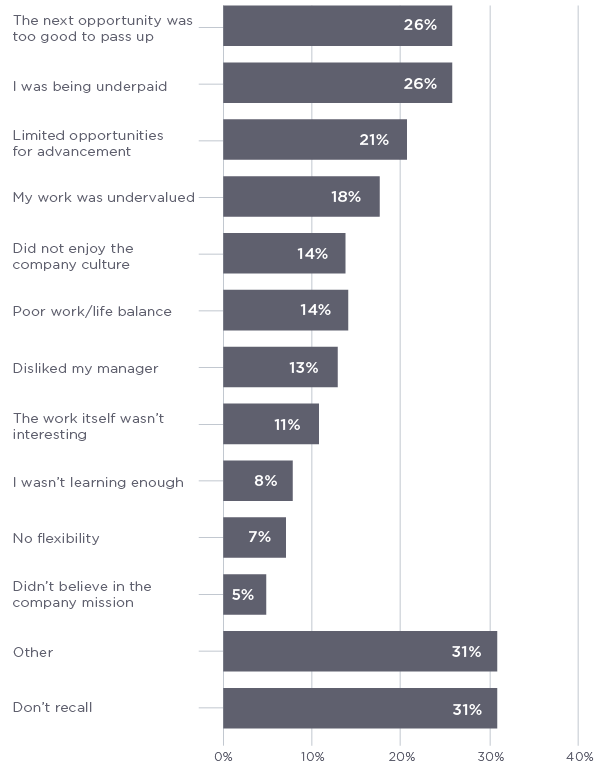
Conclusion
Technology has completely transformed the way we communicate, collaborate, and create. Every single aspect of the way we work, alone and together, has been reinvented by new technologies and business models — with one exception: Innovation of the way we find work is lagging far behind the innovation of the way we do work.
Today’s job search is stressful, time-consuming, and inefficient for job seekers. Our findings show that despite being inundated with information and incessantly hounded by recruiters, people still find jobs in the same two ways: through other people, or by applying to the company directly. There is an apparent need for more relevant information about job opportunities and potential employers. People are turning to other people to get jobs, perhaps because technology seemingly isn’t facilitating actual hires.
Today’s job search serves more as an impediment to opportunity than a facilitator of it, “ says Hired CEO Mehul Patel. “It doesn’t have to be this way. Technology is rapidly evolving the way we work, providing increased efficiency, relevance, collaboration, and more. This very same technology can — and should — help people find jobs right for their skills and interests, and help companies find the people they need to succeed. When people love what they do, everyone wins.
Methodology
The survey was conducted online by Harris Poll on behalf of Hired from September 26 to October 10, 2016. The research was conducted among 2,557 full-time employed adults aged 18 or older in the following countries: US (n=1,517), UK (n=518) and Australia (n=522). Data are weighted where necessary by gender, age, race/ethnicity (US only), region, education, income, and propensity to be online to bring them in line with their actual proportions in the population.
About Hired
At Hired we believe we are entering a new era of work, where people are not looking for jobs — they are seeking opportunities. Hired is The Opportunity Network. Starting with in-demand technology, we intelligently match outstanding people to fulltime and contract opportunities at the world’s most innovative companies. By taking the pain out of the job search, we help people build purpose-driven careers and businesses find the talent to fulfill their missions. Ultimately, we want to empower everyone to find and do their best work, from one opportunity to the next.
Hired is headquartered in San Francisco, with offices in cities across North America and Europe, and plans to expand into new geographies, industries and job categories. For more information, news and tips for candidates and employers, visit Hired’s blog.
